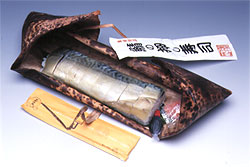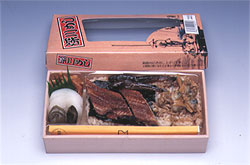| Besides feeding people at
school or work, bento are also consumed on picnics, as well as
in private homes and at parties, where they offer a convenient means of
extending simple hospitality or serving large numbers of people.
In Japan, some schools provide lunch
to the students, while others require students to bring their own lunches.
In the latter case, the students' mothers usually prepare the lunches. However,
some of the more industrious students like to make their lunches themselves.
The custom of bringing lunch from home is quite prevalent not only among
students but also among working adults.
When a person eats a box lunch prepared by a
loved one, the preparer's feelings are transmitted through the food. In
other words, the bento serves as a vehicle for communication between
the maker and the eater. A bento prepared at home is imbued with
the love of the eater's family.
But with more and more mothers working outside
the home, bento are now being sold in increasing numbers at department
stores, supermarkets, and convenience stores. There are even shops specializing
in takeout bento. Besides the ever-popular makunouchi bento,
many other kinds of box lunches are available, including Chinese-style
and Western-style bento.
Bento are also served at Japanese
restaurants. Many restaurants also offer bento for takeout, so
that people can enjoy the chef's taste in the comfort of their own homes.
As for ekiben (bento sold at train
stations), they have certainly proliferated since the Meiji period: Some
2,000 to 3,000 different kinds are sold at railway stations throughout Japan.
In addition to the makunouchi bento and sushi bento, a rich
variety of box lunches containing local specialties also compete for the
appetites of travelers. Once upon a time, bento sellers waited on
the platform for trains full of hungry customers to arrive. The vendors
carried boxfuls of bento using shoulder straps and passed the lunches
right through the open train windows. But passengers today can rarely experience
the fun of buying bento through the window while the train makes
a stop at a station. This is because Japanese trains operate on a much brisker
schedule nowadays, and also because - what with the proliferation of high-speed
trains like the Shinkansen
(bullet train) and special express trains - more and more railroad cars
have windows that cannot be opened. Still, purchasing a box lunch at a station
shop or inside the train remains one of the pleasures of Japanese railway
travel.
|





